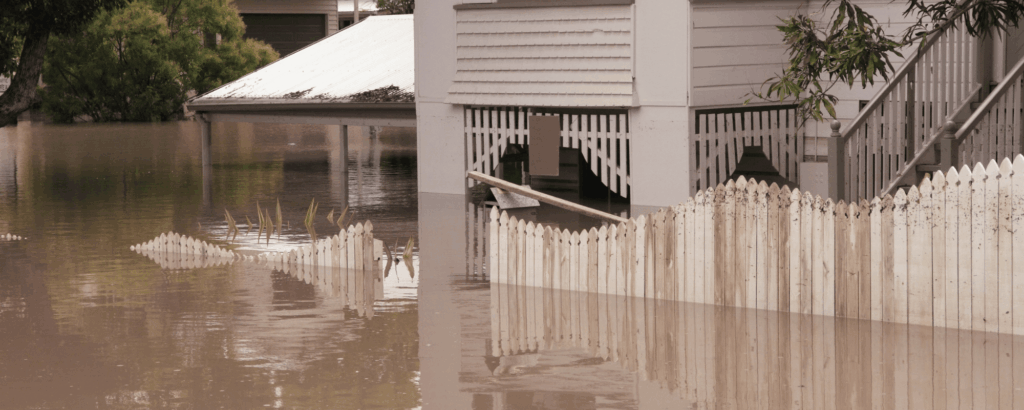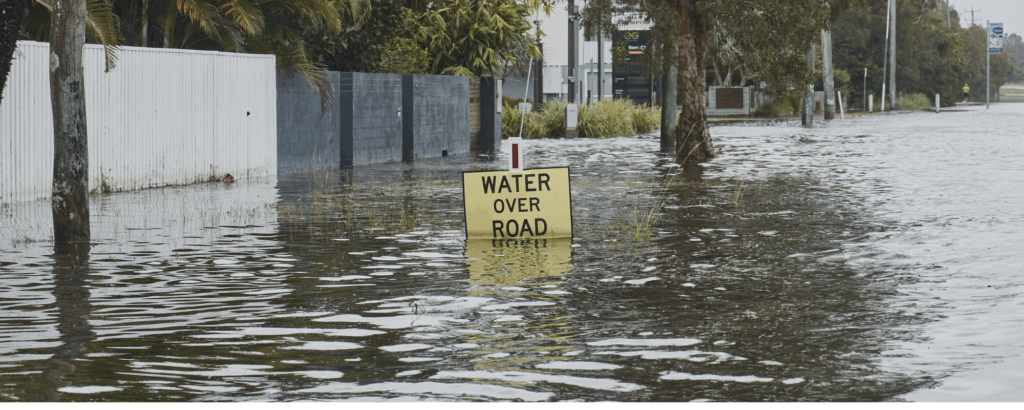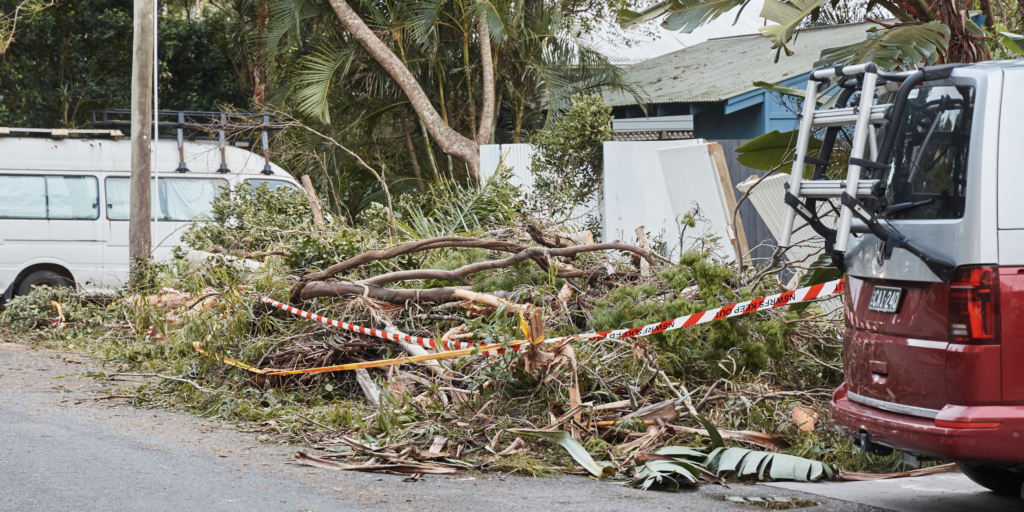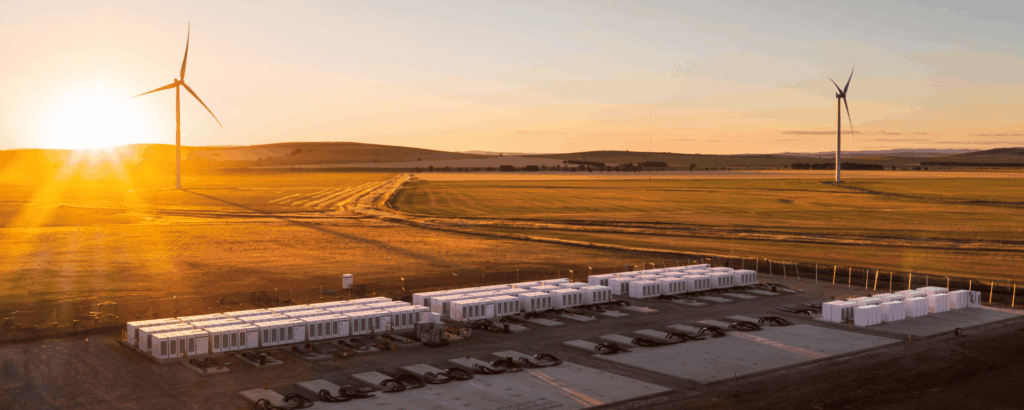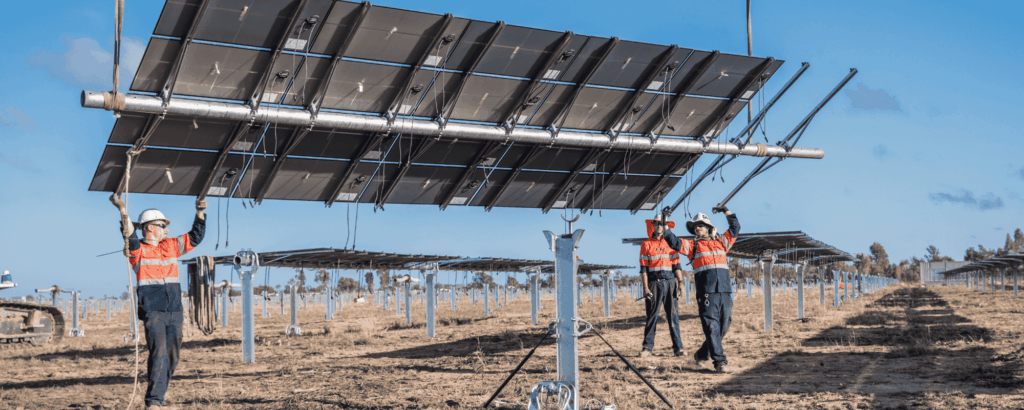The choices we make today – on how rapidly we cut climate pollution over coming years – will determine exactly how dangerous our future becomes. The Australian Government’s national risk assessment outlines the worst risks that Australia faces, from extreme heat, to flooding and drought, into the future. The only solution is to rapidly slash climate pollution from coal, oil and gas, and replace energy sources with clean alternatives.
The report comes as the Australian Government sets a 2035 climate target. In doing so it is making a choice on how much harm to Australia it is willing to accept, as Australians experience increasingly catastrophic impacts on our way of life.
This briefing paper explains the National Climate Risk Assessment (NCRA) in context, and summarises its key findings.
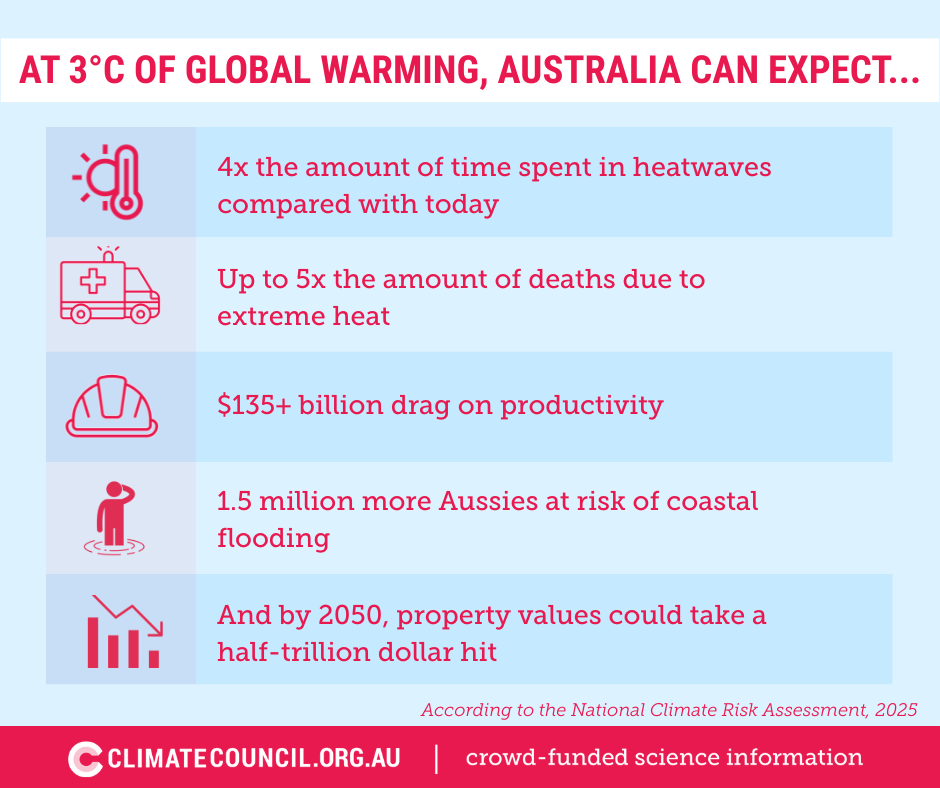
This summary was prepared based on the NCRA Overview. Climate Council researchers will analyse the NCRA’s detailed technical reports over coming days.
How bad will climate change get for Australians?
Australia is already experiencing more intense heatwaves on land and sea, rising seas and more frequent and severe flooding. What happens next depends on what we collectively do now.
Existing global efforts – including Australia’s – are insufficient to limit global heating to safer thresholds. Based on current policies to cut climate pollution, the world is estimated to heat up by 2.7ºC by 2100. This means the NCRA’s 3ºC scenario is most likely to occur based on the choices we’re making.
The NCRA has assessed climate risks and impacts in Australia at three levels of global heating: 1.5ºC, 2ºC, and 3ºC above pre-industrial levels. At these levels, it identifies severe risks with catastrophic impacts for Australians if we don’t do more to cut climate pollution. It notes that:
- Climate change will disrupt our very way of life. “Changes in Australia’s climate will not occur gradually or smoothly. Reaching potential climate and ecological tipping points is very likely to result in abrupt changes” (p.10).
- Communities will be slammed in many, severe ways. “It is likely we will experience more compounding, cascading and concurrent hazards”, like heavy flooding after a tropical cyclone, or bushfires and increased air pollution after extreme heatwaves (p. 10).

Quadruple the time spent in heatwaves (p.12)
The average number of severe and extreme heatwave days per year across Australia would:
- Double at 2ºC of warming
- Quadruple at 3ºC of warming

Deaths due to extreme heat could quintuple (p.35)¹
Heat-related deaths could increase dramatically (under a 3ºC scenario):
- Sydney: 440% more deaths
- Melbourne: 260% more deaths
- Perth: 300% more deaths
- Launceston: 140% more deaths
- Darwin: 420% more deaths
- Townsville: 330% more deaths

$135+ billion drag on productivity (p.31)
Exposure to heat would harm worker productivity, reducing overall economic output by $135-423 billion by 2063.
Agriculture, construction, manufacturing and mining would be the worst hit, losing the equivalent of 700,000 additional days of work every year by 2061 under a 3ºC scenario.

Our bill for climate-driven disasters seven times bigger (p.26)
Average Australian Government spending on disaster recovery could be almost seven times higher by 2090 under a 3ºC scenario.

Marine heatwaves for half the year (p.12)
Marine heatwave duration would increase dramatically, which would have catastrophic consequences for coral reefs:
- Quintuple to 95 days at 2ºC of warming
- Increase ten-fold to 179 days at 3ºC of warming

Millions more Aussies at risk of coastal flooding (p.39)
Sea-level rise could reach one metre, leading to:
- 18 times more coastal flooding, from an average of about 15 days per year in different coastal locations to around 272 days per year under a 3ºC scenario.
- Doubling the number of Aussies exposed to coastal hazards to 1.5 million by 2050, and exposing 3 million people by 2090.

Property values could take a half-trillion dollar hit (p.31)
Losses to property values could increase to:
- 2050: $611 billion
- 2090: $770 billion
Who is most at risk?
The report finds that the extreme weather events of today are likely to resemble the average experience of Australians in the future if we don’t cut climate pollution much further, and faster. (p.22)
All Australians will be at greater risk, with the most significant and rapid increase in risks identified for Queenslanders, Tasmanians, and those in NSW and the ACT (p.26).
With sea levels rising around Australia, and more frequent extreme events increasing, the risk of inundation and damage to coastal infrastructure and communities in low-lying areas are a major risk, including in major cities and external territories (p.22). If populations remained static, then that puts 597,000 people at direct risk of coastal hazards by 2030.
Those living in remote communities are vulnerable today because of limited telecommunications and weak supply chains (p.22). In the future, climate impacts could exacerbate this vulnerability, doubling freight costs for some regional areas in QLD, WA, and the NT (p.51).
Aboriginal and Torres Strait Islander Peoples are already experiencing the adverse impacts of climate change, which exacerbate existing health and social disparities. Displacement from Country due to climate change can have severe health and wellbeing consequences, including increased homelessness and weakening of family and social connections, identity, and belonging. Other climate risks to the health and wellbeing of Aboriginal and Torres Strait Islander peoples may be driven by reduced air quality, extreme heat, flooding, interrupted health services, and energy insecurity (p. 34).
What can we do about it?
Today’s choices are shaping the kind of world we will live in for decades. Burning coal, oil and gas is causing global heating, driving climate disruption and a more dangerous future. Rapidly cutting climate pollution can keep all of us safer. That’s why the climate targets we are about to set are so important.
The Climate Change Authority publicly drafted a target range of 65-75% reduction in climate pollution by 2035, compared to 2005 levels. Scientific analysis commissioned by the Climate Council shows that a 75% target aligns with below 2.3ºC of warming above pre-industrial levels – which means this is insufficient to keep Australians safer from many of the catastrophic climate impacts identified in this report.
Net zero by 2035 is the only target available to Australia that provides a strong chance of contributing to holding global heating below 2°C.² The higher the Government sets our climate target, the more they will be doing to help keep Australians safer.
Climate Council has launched a petition calling on the Australian Government to set the strongest possible 2035 climate target – and take urgent action to meet it.
The Climate Council is doing everything in our power to fight for the climate solutions our kids and communities deserve. That’s our job. If you’re in a position to do so, please consider chipping in to power this fight.
¹ Data sourced from Figure 4, p.35. Rounded to nearest 10%.
² For Australia, reaching net zero by 2035 and a 75% reduction by 2030 is aligned with a two-thirds chance of limiting warming to 1.9ºC above pre-industrial levels. Analysis is based on a per-capita fair share of the remaining carbon budget.




